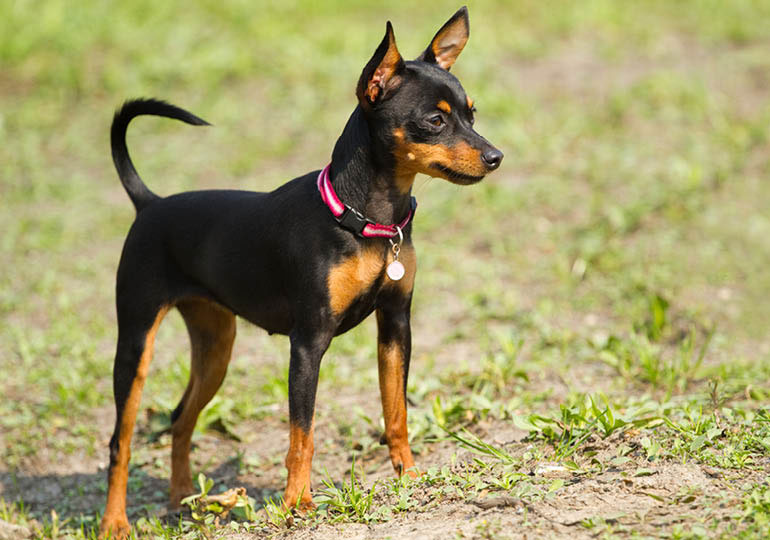Breeds
Prague Ratter

History
Historically, this breed has been known since the remote past of the Czech state. Because of its small size, quick movement and highly developed sense of smell it was used for killing rats (which gave it the name "Krysařík" = Ratter). This quality was gained during its long historical development. This small active dog was often seen at aristocratic feasts of Czech kings at the Prague castle. It adorned courts of Bohemian aristocracy and as a gift from Bohemian kings it came to other European rulers and later to the ordinary citizens. 1.
In 1980 its regeneration successfully started. This breed is again a favourite pet that lives as a family dog and is becoming popular also in many other countries worldwide. 1.
Appearance
A small, smooth-haired or medium long coated dog with an almost square and compact body. Despite its small size the Prague Ratter is a very active, alert and lively dog. 1.
This breed is characteristically black and tan, but can also come in other colours, such as brown and tan, and merle & red. General appearance should be muscular with eyes set wide apart and dark, colour according to colour of the coat.
The skin on skull has no folds and is coated with short and fine hair. Muzzle should be one third up to less than one half of the total length of the head with distinct stop. 1.
Ears are set at the back of the head, triangular, firm, naturally erected, carried in a gentle angle to the sides. 1.
Tail is straight and slender and should be set at the level of back. The tail is straight halfway up and carried slightly upright. When the dog moves it is carried higher, it can be curved over the back in a semicircle.
Hair is short, glossy, fitting close to body, thick, without bald places. Head is usually coated with thinner and shorter coat than the body.
Sizes: Height at the withers: Males and females: 21–23cm (tolerance +/- 1cm)
Weight: Males and females: optimal approx 2.60 kg 1.
Characteristics/ Temperament
Gentle, curious and affectionate. Quick with good movement and steady pace. By nature slightly reserved towards strangers but very friendly in the family. With natural nobility and character. 1.
This breed does have a strong prey instinct, which has them on high alert at the slightest movement. Due to this, a Prague Ratter is a poor choice of pets for the family that already has a menagerie of small pets. 2.
Suitability
A well socialised and brought up Prague Ratter will be affectionate, loyal and loving to his owner, and can make a great pet for the right person. However, be aware that they harbour a natural suspicion of strangers, so please source a pup from a reputable breeder who adequately socialises the pup from a young age. 2.
The Prague Ratter does best when raised using reward-based obedience training methods. This helps him to constructively direct his energy into appropriate pursuits, and makes for a contented and satisfied pet, rather than a frustrated or bossy one. 2.
This breed does have a strong prey instinct, which has them on high alert at the slightest movement. Due to this, a Prague Ratter is a poor choice of pets for the family that already has a menagerie of small pets. 2.
The Prague Ratter’s short, smooth coat is easy to care for and grooming parlour visits are not required. Simply use a brush at least once a week in order to clear away shed hair and spread his natural conditioning oils over the coat. Most Prague Ratters benefit from being bathed once a month, but take care to use a mild, moisturising dog shampoo so that the natural oils aren’t stripped from his skin and coat. 2.
The Prague Ratter does best when given regular daily walks with time off leash to romp, sniff, chase, and play. The breed loves retrieving objects and playing fetch, so harness this in order to give the dog an outlet for their natural hunting instincts. 2.
Despite his small size, the Prague Ratter will enjoy activities usually associated with larger breeds, such as dog agility or tracking. 2.
Health
Due to this breed’s small size the Prague Ratter’s bones are proportionately thinner. His leg bones, in particular, are not robust, which makes them susceptible to injuries, such as fractures. When holding him please be careful he does not leap out of your arms. Likewise, never leave him unattended on a table or raised surface, since jumping down from a height could increase his risk of breaking a leg. Also, ensure he eats a good balanced diet, which is designed for healthy teeth and bones. 2.
In common with many miniature breeds, the Prague Ratter is also prone to wobbly knee caps or ‘patella luxation’, a problem which allows the kneecap to pop out of alignment and lock the knee in a bent position. 2.
1. Dogs Australia
2. https://www.dogzone.com/breeds/prague-ratter/
In Conclusion
Now you know a little about the Prague Ratter you may think that this is the dog for you. Before you make a decision, please make contact with the breed club or your State controlling body for purebred dogs. They will be able to give you information about available puppies and also suggest dog shows, where you can see the breed and speak to breeders. In this way, you will gain perspective of the Affenpinscher and its needs and whether this breed would indeed suit your lifestyle.
Breeders
Sorry, there are currently no breeders advertising for this breed. If you are a registered Dogs SA breeder and wish to advertise here please create an advertisement here.

